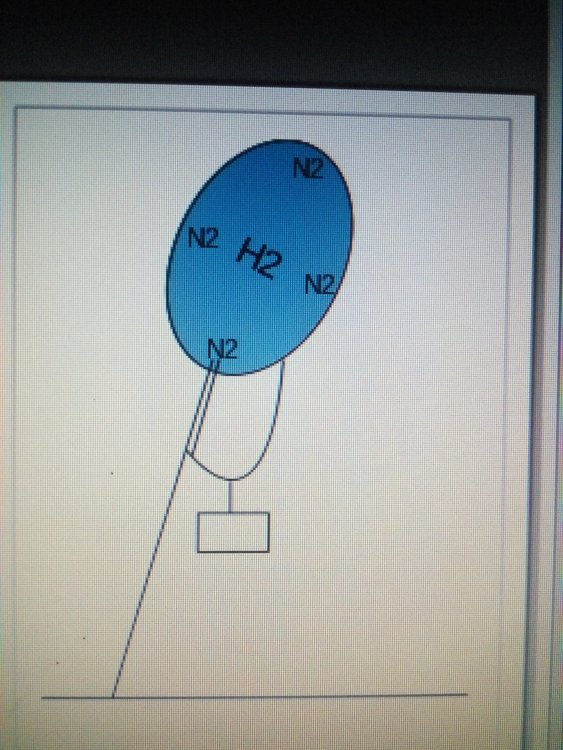-
Posts
51 -
Joined
-
Last visited
Recent Profile Visitors
2143 profile views
harlock's Achievements

Meson (3/13)
-3
Reputation
-

do you believe in future and useful h2-airship?
harlock replied to harlock's topic in Other Sciences
Where there is no space to land while a 'balloon' can be on top tied to the ground with a rope Air weighs ~ 1.225 kg/m3 while h2 ~ 0.09 kg/m3, so 1 m3 H2 gives an upward thrust of approximately 1.225-0.09(~1 with 2 bar H2) kg/m3 without considering the airship weight.. therefore the upward thrust'd be 1 ton per 1000 m3 of H2. Maybe it isn't a wrong volume. -
Here the logic is this: I do 'impossible' things to make people believe that I come from God. It was really important because Jesus brings eternal life, that is, forgiveness from original sin. Jesus time is the last about Daniel 70 weeks to be forgiven from original sin. It's an incredible importance. I think it's logic. It's not a scientific question.
-
For example an airship-hoist can be more useful than a helicopter. it's a kind of balloon in the drawing. What do you think about a useful h2-aircraft in the future?
-
Animals live on sun's energy through plant photosynthesis, all the energy they consume comes from solar energy. It means that all the solar energy that the animals(decomposers... also) used goes back to the environment (as you also say). The only 'solar fuel' of the plants that remains is trunk and branches, which store solar energy for millennia(removing it from the environment). So the difference in the amount of trees between centuries ago and today is that there is less solar energy in trunks and branches of trees. MAYBE the cycle of glaciations depends on it because there was an alternation between glaciers and forests... I say MAYBE because it's only an idea for now... Therefore neglecting this aspect is serious in the fight against global warming because we could grow more tree crops, recover agricultural residues for steam engines..., raise livestock in symbiosis with forests (goats. They feed on leaves and have the best milk), use palm oil as fuel ..., etc...
-
Why politicians only talk about CO2? But, what if they don't believe in the Lavoisier quote(atheism...)!
- 8 replies
-
-3
-
-the heat of wood burning in a fireplace comes from the sun because of Lavoisier quote('nothing is created and nothing is destroyed but everything is transformed')... Is it true? If it's true it means that a tree removes heat from the environment as it grows, therefore the difference in the quantity of trees (wood...) means that there is more solar heat in the environment compared to centuries ago and it can justify global warming regardless of the presence or absence of CO2... Opinions?
-

Why is it so hard to explain time? (What is time?)
harlock replied to chron44's topic in Classical Physics
It cannot be an unknown x but it's a known variable. It's particular -
The heat of the burning wood comes from solar energy. So trees store solar energy by removing it from environment. The absence of trees causes a greater dispersion of solar energy in the environment causing an increase in temperature(Global Warming regardless of CO2). All the wood mass we see is related to the solar energy stored by the trees for many years. (I haven't considered the fruits of the trees etc, which in a year decompose and release solar energy and CO2 again) About it 1-Can there be a relationship between glaciations-forest decrease and forest increase-ice retreat(Glaciations cycles. Regardless of CO2)? 2-How much does it affect global warming?
-

steam thermal efficiency in the transportation sector
harlock replied to harlock's topic in Engineering
Surely pellet(solid fuel) from agricultural residues would replace a liquid carburant(diesel especially...) where it'd be possible to use it(in agricultural machines for example). Please note I read that one hectare of sugar cane produces 10 tonnes of dry bagasse and 10 of dry leaves left in the field(They aren't used to obtain sugar). It's an incredible resource to have solid fuels... It's energetically equivalent to around 8E3 litres of diesel without considering efficiency etc... -

steam thermal efficiency in the transportation sector
harlock replied to harlock's topic in Engineering
Surely it's a good option. -

steam thermal efficiency in the transportation sector
harlock replied to harlock's topic in Engineering
It isn't a problem for agricultural vehicles... However solid ash represents only 3% as regards the combustion of wheat straw. Also corn stove pellets are interesting(especially in the U.S.). Infact corn stover left in the field after grain harvest represents an estimated yield of 8-10 tonnes of dry matter per hectare! In addition it seems to have a solid ash content about 5%. It doesn't seem a high value. -

steam thermal efficiency in the transportation sector
harlock replied to harlock's topic in Engineering
I think some energy needs to be stored first of all. Energy can be stored by melting some salt...or by storing water under pressure in an insulated tank... For example I know that NaCl heat of fusion value is around 30 kj/mol ( 300 kwh/m3! ) so 1 m3 of NaCl can store 300 kwh of thermal energy. But it's a high fusion temp for straw combustion... -
I read that the most (however I'm not sure) efficient steam coal-fired train was 27% efficient in the past century 🙂 link: steam train thermal efficiency. (browse pages up to the Third Generation Steam(TGS)). So...I wonder if it's possible today to build biomass-fueled steam engines for bulky vehicles(agricultural etc...). Energy content of 1 liter of diesel is equivalent to 2.5 kg of wheat straw pellet(An example). BUT 1 liter of diesel costs around 1.5 u.s. dollars while 2.5 kg of wheat straw pellet is around 0.25 u.s. dollars. Problems can be: 1-wheat straw availability 2-power 3-volume I'll try to give some answers to these three questions 1-Wheat straw yield is about 3-6 tonnes per hectare. It's energetically equivalent to more than 1 tonne of diesel... Is there availability for agricultural vehicles and (maybe) trucks in general? We'he to consider efficiency also... 2-Vapour pressure can produce a great power. We know that Force=Pressure*Surface so if vapour pressure is 100 bar(In the water state diagram T is around 300°C) and surface is only 1 cmq we have F= 100 * (1e5 Pa) * (1e-4 mq) = 1e3 Newton! It's the force applied to low-middle power cars... I think it's no comments... What about efficiency? It would've to be around 27%... Comments? 3-Wheat straw pellet density is about 0.5 kg/dm3. So 5 'liters'(2.5 kg /(0.5 kg/dm3) ) of wheat straw pellet is energetically equivalent to 1 liter of diesel(So five to one about volume energy comparison). Would it be ok for bulky vehicles?
-
-
Is there an error in the calculation of the energy stored in the capacitors? The fact is that the charge doesn't tend to zero but to the electron charge...





















